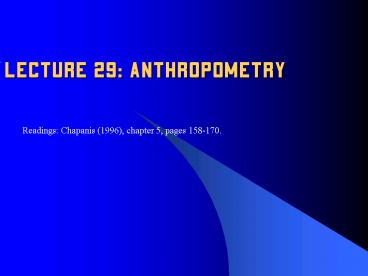Lecture 29: Anthropometry - PowerPoint PPT Presentation
1 / 27
Title:
Lecture 29: Anthropometry
Description:
... shape that is useful to designers in designing products, workspaces, and workstations. ... Anthropometry is the study of body size and shape and its ... – PowerPoint PPT presentation
Number of Views:651
Avg rating:3.0/5.0
Title: Lecture 29: Anthropometry
1
Lecture 29 Anthropometry
Readings Chapanis (1996), chapter 5, pages
158-170.
09/10/99
2
Goals
- Introduce basic information about size and shape
that is useful to designers in designing
products, workspaces, and workstations. - Show how information about size and shape is
collected
3
Definition
- Anthropometry is the study of body size and shape
and its distribution in various populations.
4
Dimensions of the Human Body
- heights,
- breadths,
- depths,
- distances.
- circumferences,
- and curvature,
5
Workzone - Dimensions at Work
6
Design Strategies to Accommodate Body Differences
- Make a single size fit all users.
- Fit 5th to 95th Percentiles
- Make equipment adjustable.
- Make equipment in several sizes.
7
Measuring Instruments
- Tape measures
- Wall charts
- Calipers
- Specialized instruments
8
Arm Circumference
9
Measuring Circumference
10
Reference Points for Arm Length
11
ChildBodyLength
12
Types of Measurement
- Height - point-to-point vertical measurement
- Breadth - straight-line horizontal measurement
- Depth - straight-line point-to-point front-back.
- Distance
- straight-line, point-to-point btwn body landmarks
- Curvature
- point-to-point measurement follows body contour
- Circumference
- closed measurement follows a body contour.
- Reach
- point-to-point measurement of long axis arm or leg
13
Upright Posture
14
Seated Posture
Thighs are horizontal Lower legs are vertical
Feet are flat on the floor
15
Reference Planes and Descriptive Terms
16
Landmarks in Frontal View
17
Functional Anthopometry
- Anthropometry in Action
- Movement through space
- Strength related to position
- Design of workspaces
18
Defining Position Accurately
19
Tables of Percentile Measurements
20
Seated Reach
21
Light downward forces can be exerted at knee
angles of about 105 to 110 degrees
22
Strong forward forces require knee extension at
135 to 155 degrees
23
Couplings between Hand and Handle
24
More hand/handle Couplings
25
Effects of Elbow Angle on Elbow Torque
26
Anthropometry and Human Requirements
- Understand the nature of the requirement.
- Collect scientific information about how that
requirement applies to different people, tasks,
and environments. - Develop design guidelines for particular
situations based on the available scientific
information. - If necessary, do new applied research on how
human requirements apply in current situation of
interest.
27
Lessons
- Anthopometry illustrates how to derive and apply
Requirements - Define Quantities that are Relevant
- Measure Accurately
- Design Accordingly































